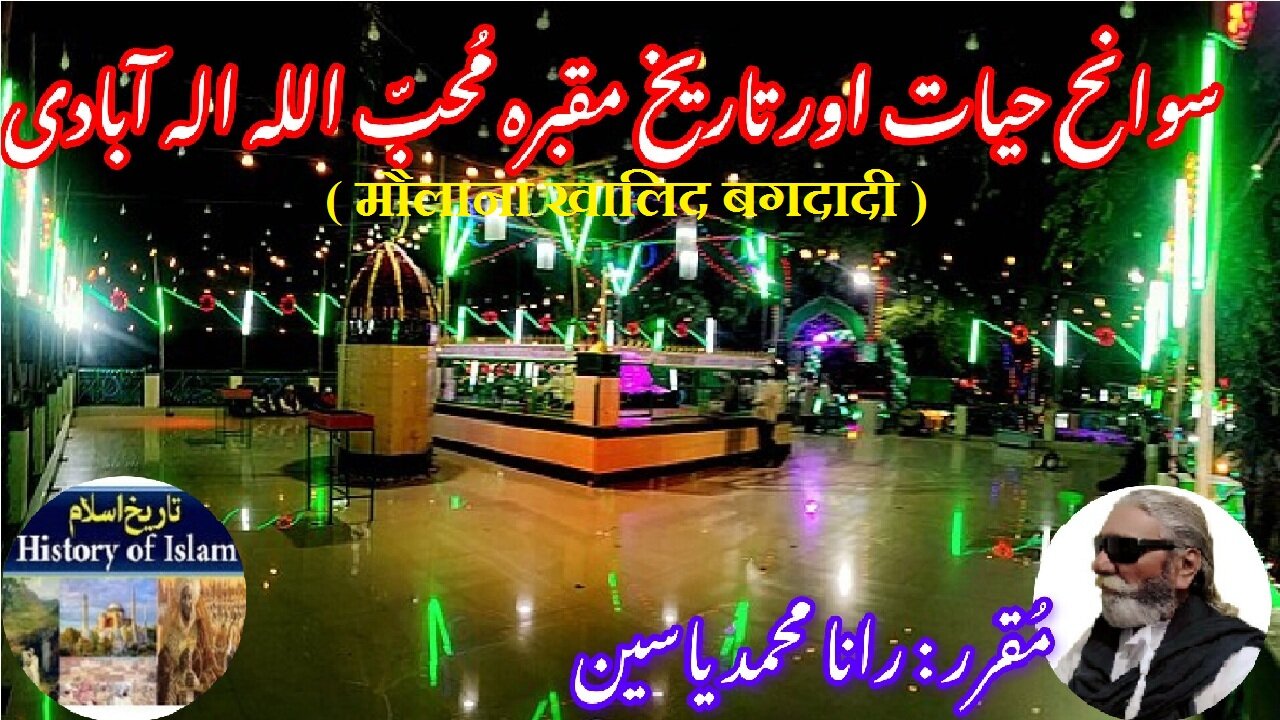Premium Only Content

Muhibullah Allahabadi मुहिबुल्लाह इलाहाबादी محب اللہ الہ آبادی کی سوانح حیات اور ان کے مزار کی تاریخ
@islamichistory813 #sufisaint #muhibullahallahabadi #culturalheritage #biography #islamicmysticism #islamicphilosophy #shrine #historicalfigures
Biography of Muhibullah Allahabadi and the history of his shrine
Dekhti Aankhooon aur sountay kaanoon ko Asslamoalaikum, sisters, brothers friends and elders, in informative series videos of Islamic ascolars, sufisaints, cultural heritages, islamic philosophys, islamic mysticisms and historical figures. today we are describing biography of Muhibullah Allahabadi and the history of his shrine.
Muhibullah Allahabadi, or Muhibb ullah Ilahabadi was a Sufi scholar who was active in Allahabad in northern India during the reign of the Mughul emperor Shah Jahan. He is noted as a leading proponent of the Sufi doctrine of Wahdat al-Wujud, sometimes called "Oneness of Being". Some Sufis consider that he was a saint.
Muhibullah was born in 1587in India. He was a descendant of Fariduddin Ganjshakar. His home was in Sadarpur in Awadh. There he compiled a commentary in Arabic on Ibn Arabi's Fusus ul-Hikam. He was initiated into the Sabiriya branch of the Chishti Order of Sufis with the help of Shaikh Abu Said Gangohi, and visited major Chishti places of pilgrimage and centers before settling in Allahabad in 1628, where he spent the rest of his life. He was active during the reign of the Mogul emperor Shah Jahan. Muhibullah founded the Indo-Islamic literary culture in Allahabad, with his many writings on obscure Sufi topics in both Persian and Arabic.
In Muhibullah's view social relationships should be guided by the unity of Being. He was the preceptor of Shah Jahan's son, prince Dara Shikoh. In response to an inquiry from the prince he wrote that the state should not make a distinction between Muslims and Hindus, since God did not discriminate between his creations. God had sent Muhammad as Rahmat al Alameen, mercy for all of creation, not only for Muslims. Many devotees visited Muhibullah's Khanqah, including both Moslems and Hindus. Muhibullah thought that mystic knowledge could be obtained from Hindus, and quoted the Hindu theory of cosmogony in a letter, but seems to have had no more than a very superficial understanding of Hindu mysticism.
Muhibullah followed the teachings of Ibn Arabi (1165–1240), the great Sufi poet and mystic from Andalusia, and was himself called Shaikh-e Kabir (the great master). Ibn Arabi had formulated the most advanced formulation of the Tawhid wajudi (Wahdat al-Wujud) doctrine, a fundamental Sufist doctrine. In the Sufi interpretation of the doctrine the face of God is seen everywhere, but that does not mean that everything that exists is an aspect of Divine unity. Muhibullah Allahabadi strongly supported the Tawhid wajudi doctrine, and was called Sheikh Ibn Arabi II because of his depth of understanding of the doctrine. Muhibullah wrote several books, most notably Taswiyah, in which he ardently defended the doctrine. The doctrine was highly fashionable during Akbar's reign (1556–1605), because Sheikh Tajuddin Zakaria Ajodhini used to talk of it privately to Akbar.
Muhibullah considered that the works of Ibn Arabi should not be interpreted either literally or metaphysically, and had more respect for Ibn Arabi's critics such as Shaikh Ala ud-Daula Simnani and Mir Saiyid Muhammad Gesu Daraz than for commentators who simply glossed over Ibn Arabi's work. He was opposed by Mulla Mahmud Jaunpuri (of Jaunpur) and his followers who attacked Sufism in general and emphasized the importance of rational thought as opposed to dogma and mysticism. Some ulama said that his views about Appearance and Reality were heretical, and Muhibullah should not be considered a Muslim. A fatwa was issued for his execution, which was only averted with considerable difficulty.
Aurangzeb (r. 1658–1707) may have suspected the orthodoxy of the doctrine of wahdat-ul wajud propounded by Shah Muhibbullah. Aurangzeb threatened to burn his book in which he called Gabriel a hidden spiritual power in the Prophet rather than a winged angel. It is said that Aurangzeb summoned Muhibbullah's disciple Sayyid Muhammad Qannauji, and asked him to explain how some of Muhibbullah's statements could be reconciled with Sharia. Qannauji replied that he could only explain Muhibbullah's words when he reached a similar spiritual status, which was far above his present condition. He also said that the emperor had enough fire in his kitchen and did not have to use a poor man's fire.
The important shrine of Daira Shah Hujjatulla in Allahabad was founded by Muhibullah. Sheikh Mohsin Fani of Kashmir, a disciple of Molla Serf, celebrated Muhibullah in one of his poems. Muhibullah had invested Mohisan Fani in the sacred costume of the Dervish. Muhibullah was considered an important saint by the Sabiriya order of Sufis, founded by Alauddin Sabir Kaliyari. In the early 20th century the month of Rajab was treated as a time for holiness and festivities in Allahabad, since it was not just the month of the Prophet's ascension but also the month of Muhibullah's urs.
The Urs (death anniversary) of Shah Muhibbullah Allahabadi is celebrated at the Dargah shareef Kydganj Dargah And Bahadurganj Khanqah on the 8th-9th of Rajab
With this, we seek your permission until tomorrow, tomorrow we will describe the biography of Aisha Al-Manoubya and the history of his Shrine. Allah Hafiz.
==================
-
 11:48
11:48
ISLAMIC HISTORY
8 minutes agoIslamic History Episode 60 | The victory of Haira | हेरा की जीत | حیرا کی فتح
-
 LIVE
LIVE
Dear America
10 hours agoElon Accused Of Shorting Child Support?! + Trump Hosts Kid Rock & AG Bondi Sends STRONG Warning!
3,804 watching -
 LIVE
LIVE
2 MIKES LIVE
1 hour agoTHE MIKE SCHWARTZ SHOW with DR. MICHAEL J SCHWARTZ 04-01-2025
110 watching -
 1:22:44
1:22:44
Game On!
12 hours ago $5.49 earnedGrassGuy is EXCITED for Tom Brady's RETURN as Raiders QB1! April Fools'!
25.5K2 -
 34:50
34:50
The Rad Factory
23 hours ago $6.00 earnedCan We Fix Everything Wrong With My Fake F1 Car??
32.2K11 -
 19:53
19:53
CatfishedOnline
13 hours agoMan Dates Jennifer Aniston Or Online Romance Scam?
30K13 -
 11:40
11:40
Shea Whitney
16 hours ago $4.48 earned20 Best *DESIGNER INSPIRED* Items on Amazon!
34K4 -
 11:05
11:05
Hannah Barron
23 hours agoFirst STEELHEAD Trip!
35.6K13 -
 1:00:13
1:00:13
Trumpet Daily
22 hours ago $7.42 earnedThe World Realigns Against America - Trumpet Daily | Mar. 31, 2025
39.5K26 -
 11:08
11:08
This Southern Girl Can
14 hours agoDIY Spring Wreath
39.4K3